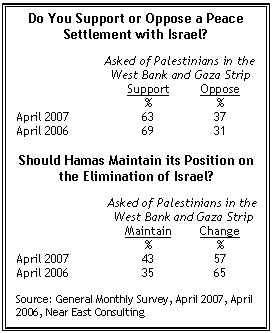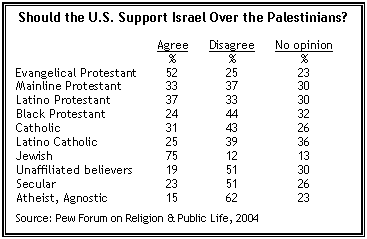by Robert Ruby, Senior Editor, Pew Forum on Religion & Public Life
It was famously a six-day war, and in varying guises the conflict has so far lasted another 40 years.
For six days, beginning June 5, 1967, Israel battled Egypt, Jordan and Syria. As a result of the fighting, Israel won control of the Sinai desert, the Gaza Strip, East Jerusalem, the West Bank and the Golan Heights.
For all of the 40 years since then, substantially larger numbers of Americans have placed their primary sympathy with Israel rather than with Arab states or with the Palestinians. That support is a near constant in American public opinion about the Middle East, beginning with Israel’s creation as a state in May 1948.

The 1967 combatants unknowingly planted the seeds for much of what was to come: the rise of the Palestinian Liberation Organization, another all-out Arab-Israeli war in 1973, construction of Jewish settlements in the West Bank and Gaza, a peace treaty between Israel and Egypt, a war in Lebanon, the first Palestinian uprising, peace accords between Israel and the PLO, a second Palestinian uprising and, in 2006, a second war in Lebanon. Because of the speed of the Arab states’ defeat and their loss of territory to Israel, the 1967 war also brought discredit to secular governments in the region and contributed to the rise of Islamist politics. In both Israel and the Arab world, the war helped make religion rather than just nationality, seem a cause worth fighting for.
American Support for Israel Rarely Wavers
Public opinion surveys over the years show that Americans’ lopsided division of support in favor of Israel has persisted through every war in the region, through the making and collapse of peace agreements and through attacks and reprisals by all sides. The changing fortunes of Labor and Likud governments in Israel seemed to have little lasting impact on American sympathies. Neither has the rise and fall of Arab leaders, the central role gradually taken by the PLO or, since the late 1990s, the rise of the Islamic party Hamas.
Of course, as shown by the chart, variations in attitudes toward both Israel and the Arab states or Palestinians may be associated with particular events. American support is often nuanced. In particular, support for Israel tends to rise when that nation is threatened and fall when Israel is perceived to be the aggressor. In 2002, for example, after Israel launched a military offensive in the West Bank following a series of Palestinian suicide bombings, about two-thirds of Americans surveyed said Israel was justified in defending itself, but nearly as many said Israel should use greater restraint and make greater efforts to avoid civilian casualties. Pew Research Center President Andrew Kohut noted that while Americans have consistently favored the Israelis over the Palestinians, “average Americans see shades of gray in the Middle East conflict, and their sympathies notwithstanding, they favor a neutral role for the United States.”1

Looking back to the start of this 40-year history, a Gallup poll, conducted during the three days before the outbreak of the 1967 war and extending through the first three days of the fighting, found 45% of Americans sympathized more with Israel than with the Arab states, 4% sympathized more with the Arab states and 26% with neither. Another 24% had no opinion.
Six years later, on the eve of the 1973 war, the figures were virtually unchanged (45% had more sympathy for Israel, 5% for the Arab states, 23% for neither). Whatever the intervening events and whatever the bellicosity of leaders in the region during that period, the dips and rises in sympathy for either Israel or the Arab states were small. With only small variations in wording,2 pollsters have asked Americans the same question about their sympathies almost every year since then.
From late 1973 to the late 1980s, public opinion became somewhat more volatile. A growing number of Americans sympathized more with the Arab states, but the figures remained modest: about 9% when Egyptian President Anwar Sadat visited Israel in 1977, rising to 13% in November 1978 following the signing of the Camp David Accords by Israel and Egypt in September of that year. Support for Israel dipped (to 34%) in March1978 when Israel invaded southern Lebanon, then rose during the peace negotiations with Egypt. Among the subset of Americans who had heard or read about the Mideast, about half (51%) favored Israel when it returned the last portion of the Sinai peninsula, seized during the Six-Day War, to Egypt in April 1982.
Some of that support ebbed away after Israel’s 1982 invasion of Lebanon. Within a few weeks of the start of Israel’s siege of Beirut, the number of Americans who sympathized more with Israel or more with the Arab states was nearly equal (32% sympathized more with Israel, 28% with Arab states. Another 21% sympathized with neither; 19% had no opinion.)
In the years since, public opinion follows one pattern in the case of Israel and another, inextricably related pattern in the case of the Palestinians.
A larger number of Americans sympathize with Israel when it is perceived to be facing acute threats, or when the United States itself appears to be threatened by part of the Arab or Muslim world. For example, the number of Americans siding with Israel rose (to 64%) during the Gulf War in early 1991 when Iraq fired missiles at Israel. Surveys conducted by the Pew Research Center show support beginning to ebb about the time the Gulf War ended.

Response after the 9/11 attacks against the United States was more tepid. Support rose somewhat in the weeks after (from 40% just before to 47% immediately after) but receded to 41% by the following April. It has varied only modestly in surveys over the ensuing years, hitting a low point of 37% in July 2005, and rising somewhat by that October, after Israel’s withdrawal from the Gaza Strip. Sympathy again rebounded, to a recent high of 52%, during the fighting in August 2006 between Israel and the Islamic group Hezbollah.
With regard to the Palestinians, American sympathy generally rises when relations between Israel and the Palestinians show signs of growing closer. And it falls when Americans feel threatened by the Arab or Muslim world. Support for the Palestinians jumped (to 24%) when the PLO in 1988 first promised to recognize Israel and again when Israel completed its withdrawal from Gaza (in this latter case, support for Israel also rose, with declines registered among those who responded “neither,” or “don’t know” or refused to answer). Though neither situation directly involved Palestinians, American sympathy for them fell after the 9/11 attacks and during Israel’s fighting with Hezbollah in 2006.
No Other Country Supports Israel So Strongly

In their opinions about the Israeli-Palestinian conflict, Americans are distinctly different from people in other countries surveyed by Pew. In the 2006 Pew Global Attitudes survey, support for Israel was higher in the United States than in any of the other 14 countries surveyed. In two European countries (Great Britain and Spain), more people sided with the Palestinians than with Israel. In the five Muslim countries surveyed, the Palestinians were favored by large — and in some instances overwhelming — majorities (59% in Pakistan, 63% in Turkey, 72% in Indonesia, 97% in Egypt and Jordan).
The one-sidedness of support in Muslim countries highlights religion’s relatively recent, more nearly central role in the conflict. In even their most belligerent statements on the eve of the 1967 war, Arab leaders made no references to Islam. In Egypt and Syria, leaders talked of representing the “Arab world,” not Muslims. The conflict was not yet cast in starkly religious terms; Arab leaders emphasized their secularism, not their religious faith.

Among both Israelis and Palestinians, majorities consistently say they favor a peaceful settlement of the conflict. In the West Bank and Gaza Strip, in an April telephone poll by Near East Consulting, most Palestinians (63%) said they supported a peace settlement with Israel, though the outlines of an agreement were not described. A smaller majority (57%) said Hamas — the senior member of the current Palestinian government — should no longer call for the elimination of Israel. But support for a peaceful settlement and for a change in Hamas’ policy was lower than in the year before.
Americans — including Muslim-Americans — express greater optimism than people elsewhere that an equitable solution can indeed be found. In a 2007 Pew survey, Muslim-Americans said by a margin of nearly 4-1 (61%-16%) that they believe a way can be found for Israel to exist so that the rights and needs of the Palestinians can be met. That is nearly the same response given by the U.S. public as a whole but dramatically different than the views expressed in seven predominately Muslim countries surveyed earlier by Pew. There, roughly half or more of the Muslims interviewed said Palestinian rights could not be taken care of as long as Israel existed.

Given demographic realities, Jewish support for Israel is at most a relatively small part of the overall American figure: Pew surveys find that Jews account for only about 2% of the U.S. population. However, support for Israel is especially high among white evangelical Protestants. They are also more likely than other Americans to identify their religious beliefs as the single largest influence in their support. In addition, substantial majorities of white evangelicals believe that Israel was given by God to the Jews (69%) and that Israel helps fulfill the New Testament prophecy of the second coming (59%). That greater support for Israel is also true of Hispanic evangelicals, compared with Hispanic Catholics and secular Hispanics.
By many measures, the 1967 war changed everything yet changed little: Israel gained control over large amounts of territory, but the final disposition of much of that territory has yet to be agreed upon. Permanent, internationally recognized borders for Israel and a possible Palestinian state are yet to be set. American public opinion — which matters greatly because of U.S. influence in the region — occasionally shifts, but without significantly eroding the greater sympathy for Israel. Both in the region and in American public opinion, the conflict in its many forms continues.
Chronology of Major Events in 40 Years of Middle East Conflict
June 1967: Israel (45%), Palestinians (4%). Survey taken immediately before start of the 1967 war and during the conflict’s first three days.
October 1973: Israel (45%), Palestinians (5%). Survey conducted immediately before the start of the 1973 Arab-Israeli war and during the conflict’s first three days
October 1977: Israel (40%), Palestinians (9%). Egyptian President Anwar Sadat a few weeks from proposing to visit Israel.
December 1977: Israel (37%), Palestinians (8%). After Sadat’s November 1977 visit to Israel.
March 1978: Israel (34%), Palestinians (10%). Palestinian guerillas kill 37 Israeli civilians. Israeli forces enter southern Lebanon.
August 1978: Israel (37%), Palestinians (10%). Preparations underway for Camp David summit involving Israel, Egypt and U.S.
November 1978: Israel (39%), Palestinians (13%). Camp David Accords signed by Israel, Egypt and U.S. in September.
March 1979: Israel (37%), Palestinians (13%). Formal peace treaty signed by Israel and Egypt.
April 1982: Israel (51%), Palestinians (12%). Israel completes withdrawal from the Sinai, returning territory to Egypt.
June 1982: Israel (52%), Palestinians (10%). Israel invades Lebanon.
July 1982: Israel (41%), Palestinians (12%). Israel besieges Beirut.
September 1982: Israel (32%), Palestinians (28%). Fighting continues in Lebanon.
October 1986: Israel (61%), Palestinians (10%). Likud Party leader Yitzhak Shamir replaces Labor Party’s Shimon Peres as Israeli prime minister.
May 1988: Israel (43%), Palestinians (20%). Palestinian uprising in its fifth month.
December 1988: Israel (46%), Palestinians (24%). PLO declares independent Palestinian state, promises recognition of Israel.
October 1990: Israel (42%), Palestinians (24%). Iraq invades Kuwait in August 1990.
January 1991: Israel (64%), Palestinians (8%). Gulf War begins. Iraqi missiles strike Israel.
March 1991: Israel (60%), Palestinians (17%). Gulf War ends in February.
September 1993: Israel (42%), Palestinians (15%). Israel and PLO formally recognize each other. Jordan and Israel agree to negotiate.
October 2000: Israel (41%), Palestinians (11%). Second Palestinian uprising begins.
September 2001: Israel (40%), Palestinians (17%). Before 9/11 attacks.
October 2005: Israel (43%), Palestinians (17%). Israeli withdrawal from Gaza completed.
August 2006: Israel (52%), Palestinians (11%). Fighting between Israel and Hezbollah in Lebanon.
Notes
1Andrew Kohut, “American Views of the Mideast Conflict,” The New York Times, May 14, 2002. 2Prior to mid-1988, surveys asked about relative sympathy toward Israel and the Arab states. In later surveys the word “Palestinians” replace “Arab states.”




